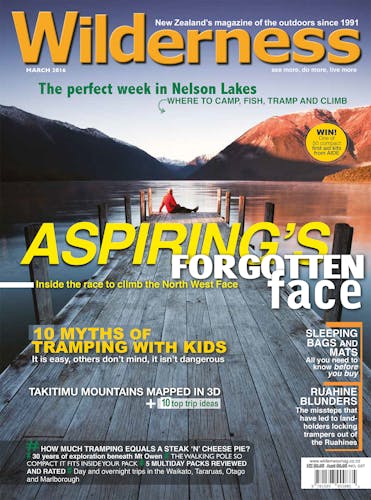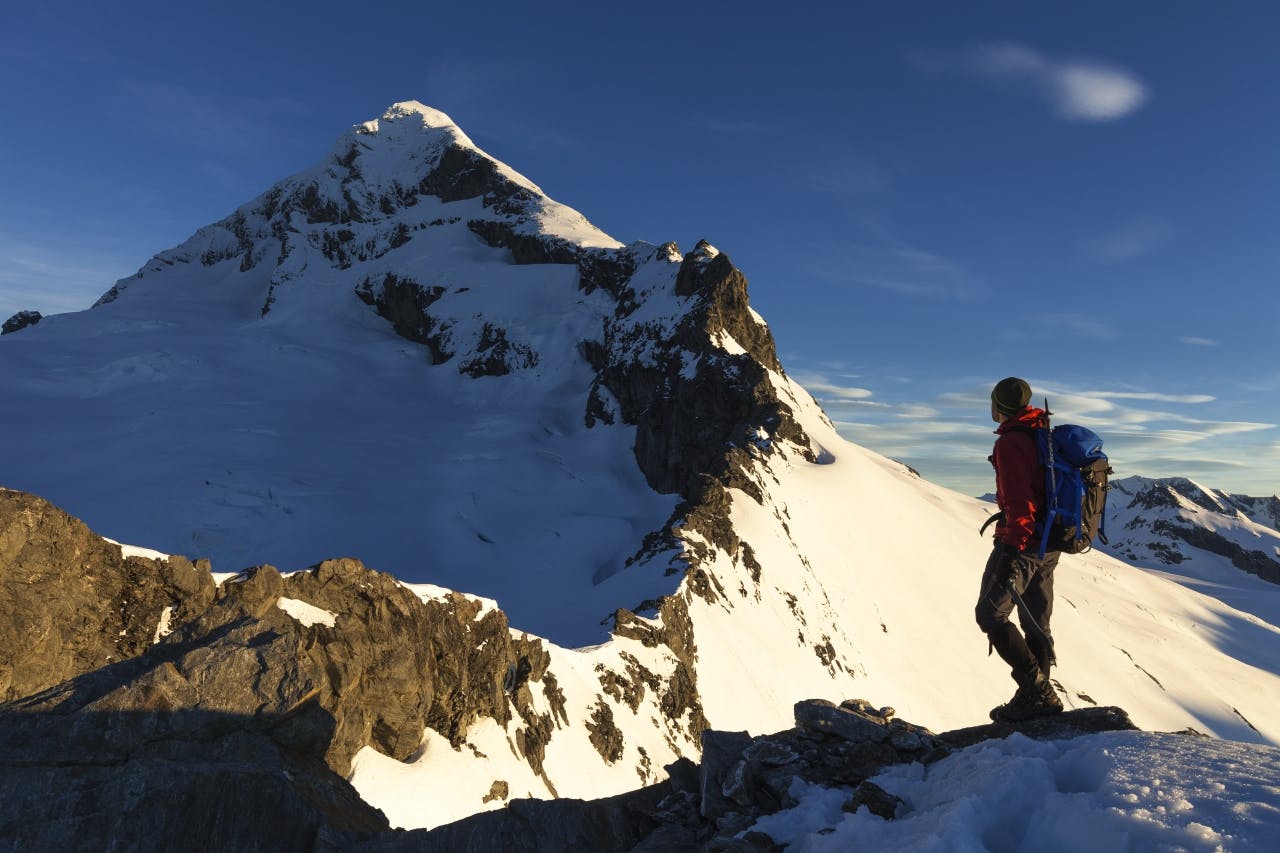The mysterious North West Face of Mt Aspiring, one of the enduring oddities of New Zealand alpinism, has finally been climbed. Naomi Arnold has the inside story
A classic beauty of a peak, Aspiring has entranced climbers for generations, and has some of the most popular mountaineering routes in the country. That’s why the virgin face on its sunset flank has always been so hard to understand.
It’s been more than 30 years since the North West Face was first attempted, but it has lain abandoned since then – until the last weekend in January, when three Queenstown mates finally conquered it.
Now Ben Dare, Steve Skelton and Danny Murphy can report it’s a wonderful trip for those hankering after a new challenge.
“It was always a bit of a head-scratcher that it’s never been climbed,” Dare says.
Dubbed the Matterhorn of the South by climbers, and Tititea (glistening peak) by Maori, at 3033m Aspiring is one of New Zealand’s premier peaks, the highest outside the Mt Cook region. Soaring above every other mountain in the range, Aspiring is something special.
The North West Face lies between Aspiring’s popular North West Ridge and the prong of the North Buttress. According to Phil Castle, one of the first people to attempt it, the area deserves to be swarming with climbers but has been mysteriously overlooked.
For 15 years, Castle, a Takaka-based software engineer, has mounted something of a campaign to see the face climbed. He wrote a piece in The Alpine Bulletin, another on his website, he wrote letters, talked to climbers, and shared information on Facebook. No one took the bait. Indeed, most people didn’t seem to know what he was talking about.
He’s now “delighted” that Dare, Murphy, and Skelton finally climbed it. “It deserves to be a really popular route on the mountain,” he says.
Climbing has moved on a lot since Castle, Mike Rockell and Hamish Mackay first attempted the face. It was March 1982 and rock climbing was in its infancy – sticky climbing boots had just arrived and Castle, a keen mountaineer, didn’t yet own a pair.
The previous summer, Rockell had been on the North Buttress and noticed an interesting area to the right. The snow ramps that usually covered it had disappeared with the summer’s warmth, leaving behind smooth slabs of rock. He thought it looked full of potential.
Even back then, the trio couldn’t believe there was an unclimbed face on Aspiring. But they struggled on the climb, battling smooth slabs, steep walls, and challenging overhangs, hauling packs and getting stuck. When snowmelt saturated Castle and Mackay, bivvying became unwise, and at around 6pm they had to abseil home. They intended to return for another crack – but life intervened and they never managed it.
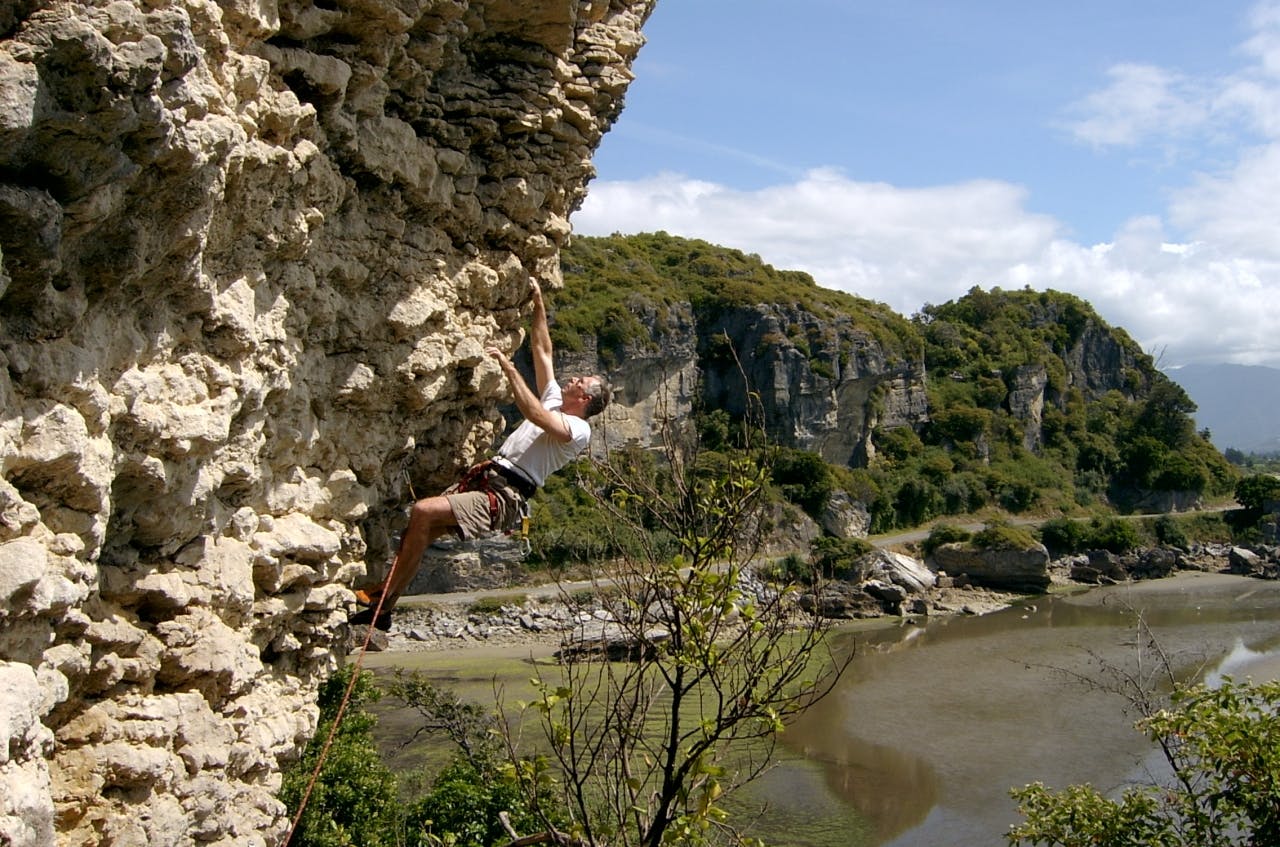
Phil Castle was among the first to attempt the North West Face and is delighted it’s finally been climbed. Photo: Britta Steude
Castle has climbed Aoraki/Mt Cook a couple of times as well as other respectable peaks. But Aspiring’s North West Face was another level entirely.
“This was an order of magnitude more – far more difficult than what I could climb. I was surprised at how difficult it was,” he says.
However, he reported it was a doable day trip for a competent party, particularly with modern gear. It was also easily accessible from the New Zealand Alpine Club’s 12-bunk Colin Todd Hut at the base of the North West Ridge, one of the most cherished huts in the country for climbers.
“It’s surprising how everyone streams up the same well-beaten route, and if you look off that, there’s stuff that hardly gets climbed at all,” Castle says.
He describes the rock as beautiful and flawless, the best rock he’s seen outside Fiordland’s Darran mountains.
“It’s very good quality, hard climbing, and that’s what a lot of climbers are looking for,” he says.
Rockell, now based in Melbourne, also recalls the rock quality was good, and the face they abseiled back down “superb”.
Now Dare, Murphy, and Skelton have been there too, and they agree, grading the climb a 19. The round trip from the hut took them about 14 hours, after leaving at 5am and summiting around 4pm.
Skelton, a 38-year-old Queenstown landscape architect, says the face was “unexpectedly good”, right up to the summit ice cap. Friends Pete and Steve Harris were climbing on the North West Buttress nearby, so it was an enjoyable trip.
“It was just a really fun climb with two of my best mates, and to have Pete and Steve on the ridge to the left of us, and to all summit at the same time on a beautiful sunny January afternoon, was magical,” he says.
To get there, the trio sidled around on the Therma Glacier beneath the face, avoiding a bit of broken icefall, finding it easy to navigate between crevasses. “It was a bit sketchy at the base because there was a hanging snowfield above us and so it was important we moved quickly,” he says. The night had been cold, and it didn’t feel dangerous, but the middle of the afternoon may have been a different story.
“I expected it to be good and fun, because it’s such an awesome mountain, but the rock climbing for the first six to seven pitches was outstanding; the quality of the climbing, the movements we were doing, the exposure and the view,” he says. “It was a really good wall.”
The rock strata moved them left, towards the North Buttress, and Skelton and Dare say there’s still a harder route, about a grade 21-22, that could take people on a more direct line up the wall.
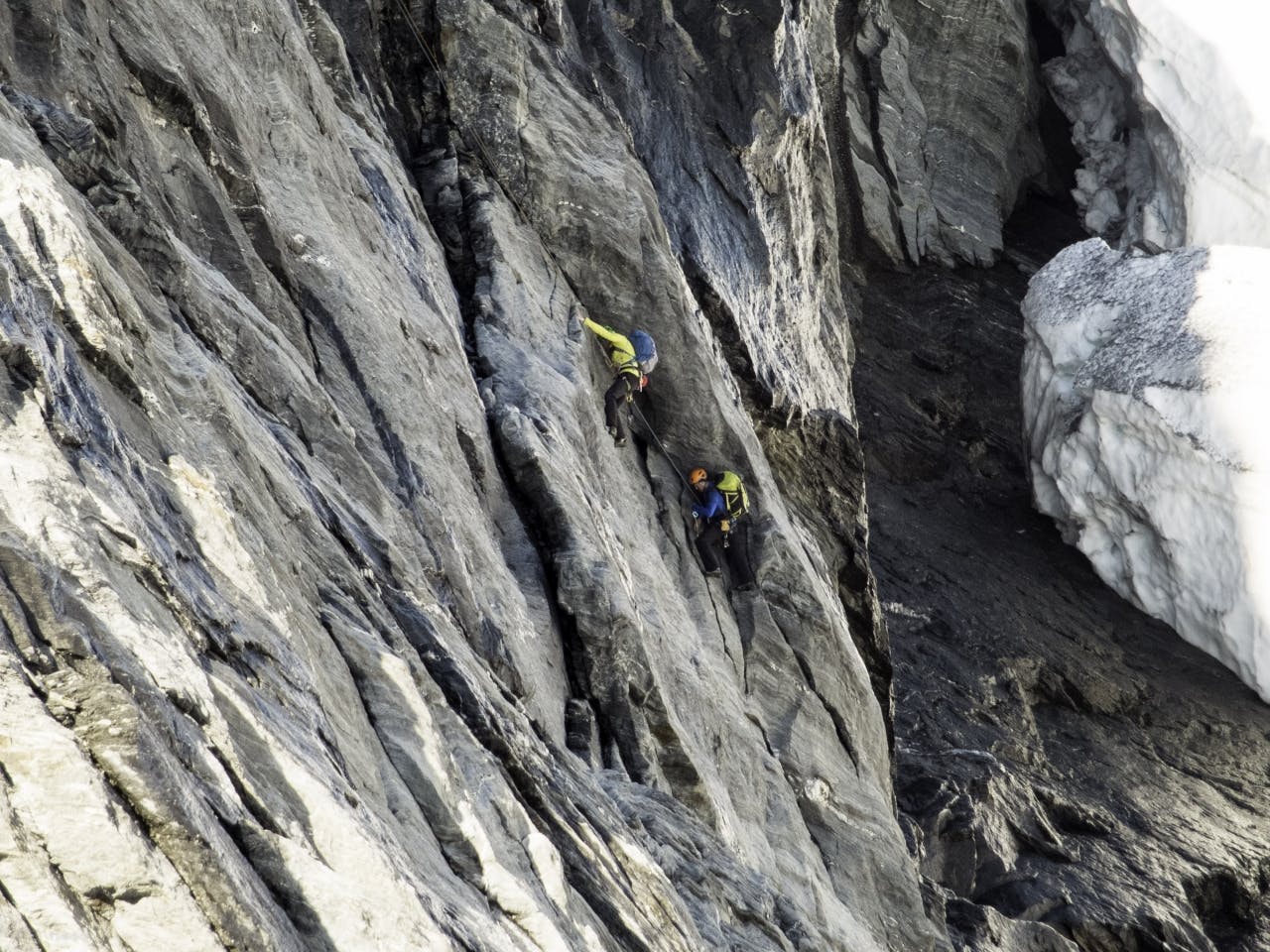
Ben Dare and Danny Murphy on the second pitch of the climb. Photo: Steve Skelton
“Everyone said the rock was chossy,” Skelton says, using a climber’s term for rotten, Weetbix-like rock. “I was worried, but the rock was so good it just gave you holds when you couldn’t see them. You started moving with uncertainty and there were amazing holds right when you needed them.”
The views back to the Therma Glacier were superb, and so were those of nearby Skyscraper and the Waiatoto River. They were also a nice change from the views of the Bonar Glacier from the North West Ridge, he says.
“With the North West Ridge cutting the Bonar off, you feel like you’re on the West Coast. It was the best summer route I’ve climbed in the mountains.”
So why did a face on Mt Aspiring remain unclimbed for so long? Castle believes it was because people were unfamiliar with that side of Aspiring, couldn’t see it well from the popular routes, and simply assumed all the faces had been climbed.
“I think how [Castle and Rockell] reported it to be quite difficult might have put people off a bit, with that area not being known for great quality rock,” Dare, a 32-year-old structural engineer, says.
“And access can be hard,” he adds, noting the Therma Glacier gets “very cut up in summer”.
But it was fine, he says. “No issues at all. Hopefully now we’ve gone up there it might dispel a bit of mystery and intimidation and will encourage people to give it a try.”
Not helping matters was that parts of the mountain are mislabeled in some popular literature. Hugh Logan’s book Classic Peaks of New Zealand mislabelled the mountain in the photo, though was correct in the text; and the ClimbNZ website also listed the faces and ridges incorrectly. The Mount Aspiring Region Guide doesn’t even mention it.
Castle also thinks there was a view, in days gone by, that the rock on Mt Aspiring wasn’t that good. “But parts of it are, and I think people really just didn’t turn their mind to it. It’s one you have to really look at to see.”
Or perhaps it was just waiting for the right people. Wanaka-based climber and adventure writer Allan Uren says it’s exciting to have a quality long rock climb close to Colin Todd, but he never thought much of the face.
“I’ve looked at that face for years but it’s never caught my eye,” he says. “It takes someone to go and climb it and say ‘Wow, that’s amazing’.
“It makes all of us who’ve walked past it look a bit daft. I hope they call it something like ‘Nabbed from Under the Old Farts’ Noses’.”
However, he says there’s so much to climb in New Zealand that things do get missed, particularly if they’re not aesthetically striking.
“These guys are young and looking at things slightly differently, looking between the lines,” he says. “I’m really excited it’s been climbed and in good style.”
Such attempts are good for the sport, he adds. “Back in the bad old days in the 70s and 80s there was a terrible sense of competition for new routes in New Zealand. People were covetous of the big new lines in Aoraki/Mt Cook National Park and wouldn’t share the knowledge, and would get quite nasty about it – competitive, and [would] beat each other down.”
There’s still competition, he says – but it’s healthier. He thinks it was a generational shift, part of New Zealand maturing as a nation, becoming better sportsmen and collectively less insecure.
“It’s changed, especially amongst these new guys. They really encourage everyone and share information. Because there are so few people doing it in New Zealand, if you cooperate and have a nice feeling of camaraderie it’s better for everybody. It’s much healthier and nicer now.”
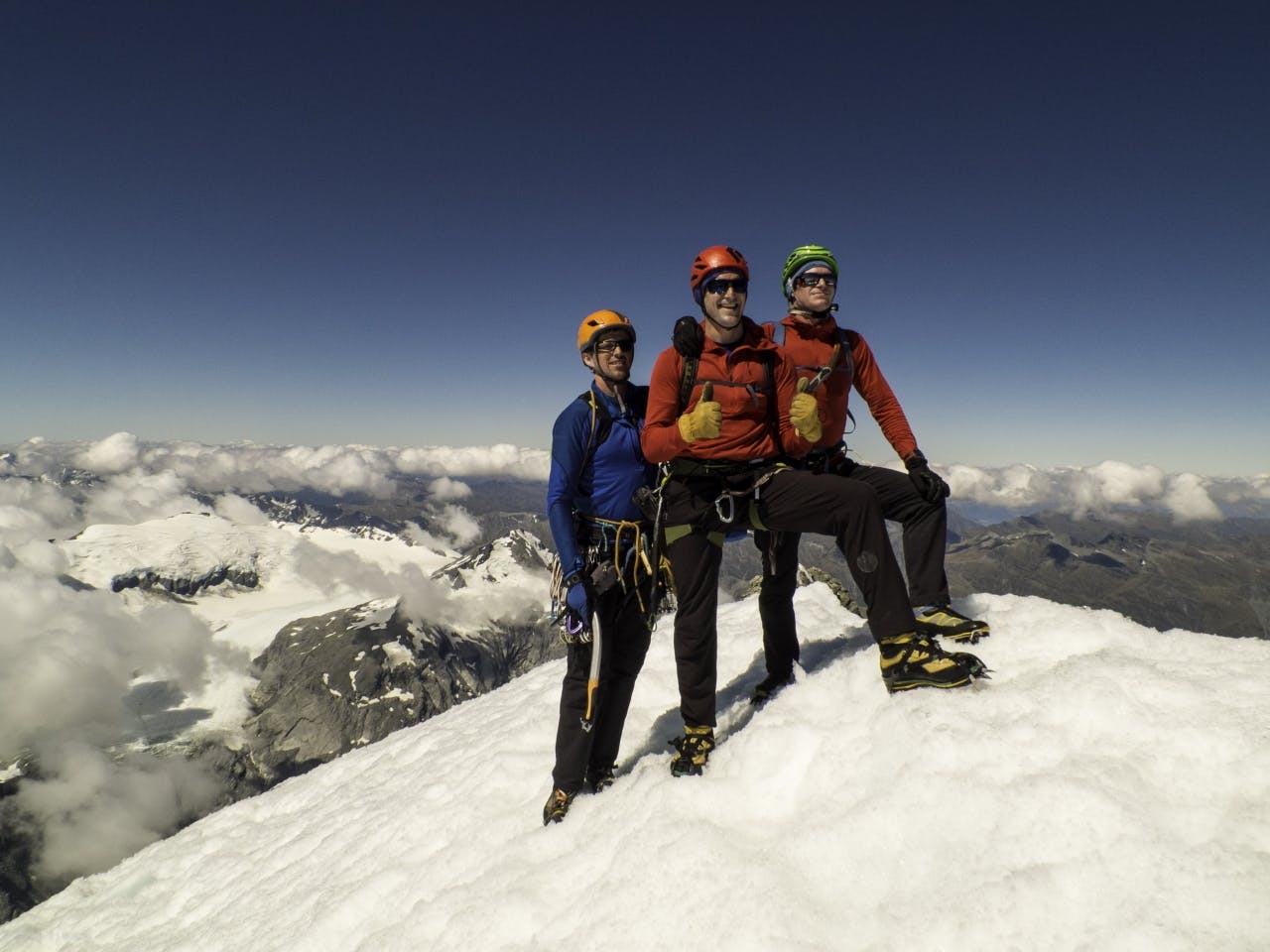
Danny Murphy, Steve Skelton and Ben Dare on the summit of Mt Aspiring. Photo: Pete Harris
But it takes a certain type of person to attempt new routes, he says. With the time pressures of today, the majority of people are happy with challenging themselves on existing or classic trips. Uren reckons he can count on one hand the people he knows who are willing to climb new routes in New Zealand.
“Only a small number of people can actually be bothered,” he says. “For the first ascensionist, climbing a new route is a wonderful journey of adventure and finding your own way – but not for anyone else.”
It is a chance, though, to have your name in lights, leaving a small legacy of treading on earth where no one has been before. He’s done about 25 new routes in the past, so knows the satisfaction well.
“To know my name is associated with [them] makes me feel proud. It’s a nice feeling.”
Dare agrees. As well as expeditions to Nepal, North America, South America, and Europe, he estimates he’s climbed about 40 or 50 new routes around the country, as well as climbing Aspiring five times on five different routes and one new climb on the south side. He avoids pre-trodden routes wherever he can.
“If I’m going to climb something, the majority of the time I will try something new,” he says. “I love the thrill of not knowing what’s ahead of me and not knowing how to make it to the top.”
In a world so carefully mapped, there’s just something about challenging yourself on the unknown.
“That’s a big part of it,” he says. “I always like to push myself physically and mentally, and when you are alpine climbing you do often have to push yourself well beyond your comfort zone and test your limits. That’s something that at the time isn’t always enjoyable. But it’s good knowing you’ve given it your all, and afterwards you can generally sit back and look back in satisfaction.”
This year, the North West Face called him. He discovered the story about five years ago, and it played on his mind ever since.
“Get out there and do it,” he says of the trip. “It was amazing – relatively easily accessible, within a couple hours’ walk of Colin Todd, the access across the glacier was good, and so was the quality of climbing. Now that someone’s done it, it will encourage a few more people to get out there and give it a crack.”
Thirty-four years since it was first attempted, and ignored ever since, the North West Face has finally been knocked off.





